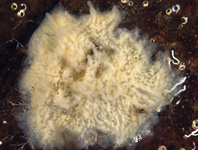Abstract
Rhinopetitia was known for a long time only by R. myersi, its type species, described from the Ilha do Bananal, Rio Araguaia basin, Tocantins, Brazil. Another recently described species, R. potamorhachia, was considered to differ from R. myersi by having the outer and inner rows of premaxillary teeth with seven to nine cusps, a midlateral dark stripe and a dark humeral blotch (versus outer and inner rows of premaxillary and of maxillary teeth with three to five cusps, and the absence of a dark midlateral stripe). Recently collected specimens from the Araguaia and Tocantins river basins are considered to belong to R. myersi, allowing to better characterize this species which is redescribed herein. Four new species are recognized for the genus, all from Brazil: 1) Rhinopetitia paucirastra, new species, collected from the upper Rio Tocantins drainage, state of Goiás, distinguished from all its congeners mainly by the presence of rudimentary and fewer gill rakers in external row on first gill arch; 2) R. oligolepis, new species originating from the Rio Jamanxim, Rio Tapajós drainage, state of Pará, differing from its congeners by having 4 longitudinal scale rows from dorsal-fin origin to lateral line; 3) R. melanohumeralis, new species, collected from small streams tributaries of the upper Rio Tapajós, and the upper Rio Xingu basins, states of Pará and Mato Grosso, that has the body as deep as in R. paucirastra but has well-developed and more gill rakers in the external row on first branchial arch; and 4) R. nigrofasciata, new species, collected in small tributaries of the upper portions of the Rio Tapajós and Rio Xingu basins, states of Pará and Mato Grosso, with the body narrower than in R. paucirastra and R. melanohumeralis.
References
Dagosta, F.C.P. & de Pinna, M. (2017) Biogeography of Amazonian fishes: deconstructing river basins as biogeography units. Neotropical Ichyhyology, 15, e170034.
https://doi.org/10.1590/1982-0224-20170034
Ferraris, C.J.Jr. (2007) Checklist of catfishes, recent and fossil (Osteichthyes: Siluriformes), and catalogue of siluriform primary types. Zootaxa, 1418 (1), 1–628.
https://doi.org/10.11646/zootaxa.1418.1.1
Fink, W.L. & Weitzman, S.H. (1974) The so-called cheirodontin fishes of Central America with descriptions of two new species (Pisces: Characidae). Smithsonian Contributions to Zoology, 172, 1–46.
https://doi.org/10.5479/si.00810282.172
Géry, J. (1964) Poissons Characoides nouveaux ou non signalés de L’Ilha do Bananal, Brésil. Vie et Milieu, Supplément 17, 447–471.
Géry, J. (1977) Characoids of the world, T.F.H. Publications Neptune City, New Jersey, 672 pp.
Hirschmann, A., Fagundes, N.J.R. & Malabarba, L.R. (2017) Ontogenetic changes in mouth morphology triggers conflicting hypotheses of relationships in characid fishes (Ostariophysi: Characiformes). Neotropical Ichthyology, 15, e160073.
https://doi.org/10.1590/1982-0224-20160073
Lima, F.C. & Ribeiro, A. (2011) Continental-scale tectonic controls of biogeography and ecology. In: Albert, J.S. & Reis, R.E. (Eds.), Historical Biogeography of Neotropical Freshwater Fishes. University of California Press, Los Angeles, California, pp. 145–164.
https://doi.org/10.1525/california/9780520268685.003.0009
Menezes, N.A. & Weitzman, S.H. (1990) Two new species of Mimagoniates (Teleostei: Characidae: Glandulocaudinae), their phylogeny and biogeography and a key to the Glandulocaudin fishes of Brazil and Paraguay. Proceedings of the Biological Society of Washington, 103, 380–426.
Mirande, J.M. (2010) Phylogeny of the family Characidae (Teleostei: Characiformes): from characters to taxonomy. Neotropical Ichthyology, 8, 385–568.
https://doi.org/10.1590/S1679-62252010000300001
Mirande, J.M. (2018) Morphology, molecules and the phylogeny of Characidae (Teleostei, Characiformes). Cladistics, 2018, 1–19. https://doi.org/10.1111/cla.12345
Netto-Ferreira, A.L., Birindelli, J.L.O., Sousa, L.M.& Menezes, N.A. (2014) A new species of Rhinopetitia Géry 1964 (Ostariophysi: Characiformes: Characidae) from the Rio Teles Pires, Rio Tapajós basin, Brazil. Journal of Fish Biology, 84, 1539–1550.
https://doi.org/10.1111/jfb.12384
Netto-Ferreira, A.L., Bastos, D.A., Sousa, L.M. & Menezes, N.A. (2016) Phallobrycon synarmacanthus, a new species of Stevardiinae from the Xingu basin, Brazil (Teleostei: Characidae). Ichthyological Exploration of Freshwaters, 27, 255–262.
Netto-Ferreira, A.L. & Vari, R.P. (2017) A new highly modified species of Creagrutus (Characidae: Stevardiinae) apparently mimetic of Prodontocharax. Copeia, 105, 368–374.
https://doi.org/10.1643/CI-16-543
Nogueira, C., Buckup, P.A. Menezes, N.A., Oyakawa, O.T., Kasecker, T.P., Ramos-Neto, M.B. & da Silva, J.M.C. (2010) Restricted-Range Fishes and the Conservation of Brazilian Freshwaters. PLoS One, 5 (6), e11390.
https://doi.org/10.1371/journal.pone.0011390
Oliveira, C., Avelino, G.S., Abe, K.T., Mariguela, T.C., Benine, R., Orti, G., Vari, R.P. & Castro, R.M.C. (2011) Phylogenetic relationships within the speciose family Characidae (Teleostei: Ostariophysi: Characiformes) based on multilocus analysis and extensive ingroup sampling. BMC Evolutionary Biology, 11, 1–25.
https://doi.org/10.1186/1471-2148-11-275
Reis, R.E., Albert, J.S., Di Dario, F., Mincarone, M.M. & Petry, P. (2016) Fish biodiversity and conservation in South America. Journal of Fish Biology, 89, 12–47.
https://doi.org/10.1111/jfb.13016
Social Science Statistics. (2018) T-test Calculator for 2 Independent Means. Available from: http://www.socscistatistics.com (accessed 20 August 2019)
Taylor, W.R. & Van Dyke, G.C. (1985) Revised procedures for staining and clearing small vertebrates and other vertebrates for bone and cartilage study. Cybium, 9, 107–119.
Thomaz, A.T., Arcila, D., Orti, G. & Malabarba, L.R. (2015) Molecular phylogeny of the subfamily Stevardiinae Gill, 1858 (Characiformes: Characidae) classification and the evolution of reproductive traits. BMC Evolutionary Biology, 15, 1–25.
https://doi.org/10.1186/s12862-015-0403-4
Zuanon, J., Bockmann, F.A. & Sazima I. (2006) A remarkable sand-dwelling fish assemblage from central Amazonia, with comments on the evolution of psammophily in South American freshwater fishes. Neotropical Ichthyology, 4 (1), 107–118.

